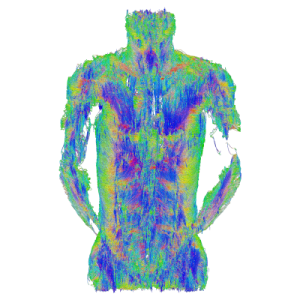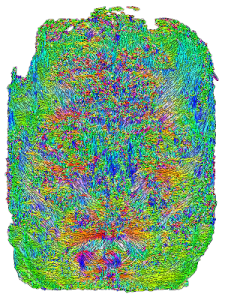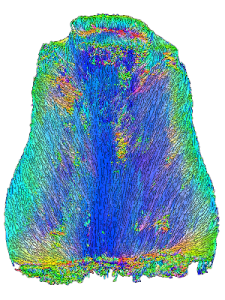Fibers
A muscle’s architecture, described by geometric variables such as fascicle pennation angles or lengths, plays a crucial role in its functionality. Usually, single parameters are used to estimate force vectors or lengthening rates, thereby assuming that they represent the architecture properly and are constant during contraction. (Stark & Schilling, 2010)
Click to start the video
 |
 |
 |
| Data: Visible Human Project | Data: Visible Human 2.0 | Data: Pig nose (pre-test) of a contrast-enhanced µCT |
- Created with the own software ImageXd and Cloud2
- The colors encode the orientation of the fibers – red:horizontal, green:depth and blue:vertical
References:
Katzke J, Puchenkov P, Stark H, Economo EP (2022) A roadmap to reconstructing muscle architecture from CT data. Integrative Organismal Biology 4 (1), obac001. DOI:10.1093/iob/obac001 / EISSN:2517-4843
Sartori J, Stark H (2021) Tracking tendon fibers to their insertion – a 3D analysis of the Achilles tendon enthesis in mice. Acta Biomaterialia 120: 146-155. DOI:10.1016/j.actbio.2020.05.001 / ISSN:1742-7061
Nyakatura JA, Baumgarten R, Baum D, Stark H, Youlatos D (2019) Muscle internal structure revealed by contrast-enhanced µCT and fibre recognition: The hindlimb extensors of an arboreal and a fossorial squirrel. Mammalian Biology 99: 71-80. DOI:10.1016/j.mambio.2019.10.007 / ISSN:1616-5047
Dickinson E, Stark H, Kupczik K (2018) Non-destructive determination of muscle architectural variables through the use of DiceCT. The Anatomical Record 301 (2): 363–377. DOI:10.1002/ar.23716 / ISSN:1932-8494
Kupczik K, Stark H, Mundry R, Neininger F, Heidlauf T, Röhrle O (2015). Reconstruction of muscle fascicle architecture from iodine-enhanced microCT images: a combined texture mapping and streamline approach. Journal of Theoretical Biology 382 (7): 34–43. DOI:10.1016/j.jtbi.2015.06.034 / ISSN:0022-5193
Nyakatura JA, Stark H (2015). Aberrant back muscle function correlates with intramuscular architecture of dorsovertebral muscles in two-toed sloths. Mammalian Biology – Zeitschrift Für Säugetierkunde 80 (2): 114–121. DOI:10.1016/j.mambio.2015.01.002 / ISSN:1616-5047
Stark H, Fröber R, Schilling N (2013) Intramuscular architecture of the autochthonous back muscles in humans. Journal of Anatomy 222 (2): 214–222. DOI:10.1111/joa.12005 / ISSN:0021-8782
Stark H, Schilling N (2010) A novel method of studying fascicle architecture in relaxed and contracted muscles. Journal of Biomechanics 43 (15): 2897-2903. DOI:10.1016/j.jbiomech.2010.07.031 / ISSN:0021-9220